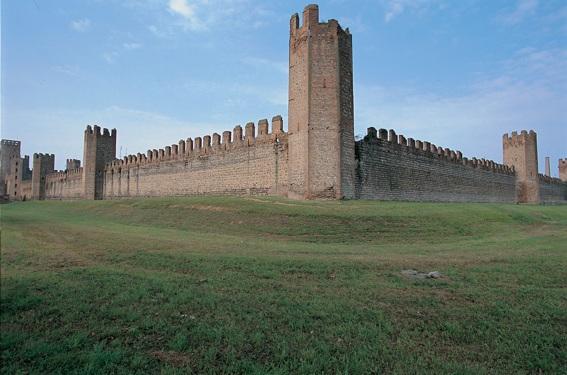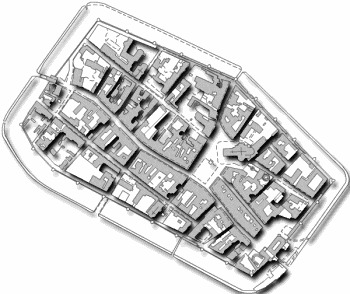|

Rising at the heart of the fertile plain enclosed between the Adige river and the Euganean Hills, Montagnana was funded in the Roman age to defend the river that washed it before 589 CE, the year when a devastating flood south of Verona diverted its course further south. Already a Lombard chief town, in the 11th century the settlement passed under the rule of the Este House that made of it an important fortified village, then conquered by the Ezzelini family and later by the da Carrara family, the Lords of Padua (1260), before the town was finally subdued to the Republic of Venice, in 1405.
That the town had an important medieval past emerges clearly when admiring the towered profile of its circle of walls, one of the most beautiful and better preserved in Europe. It has the shape of an irregular rectangle, with a perimeter of nearly two kilometres and four gates that take to the historical centre, where the current buildings were constructed from the 13th century onwards. Once all around the circle of walls there ran a moat, now filled and covered with grass to create a harmonious green frame all around the twenty-four polygonal towers connected one to the other by a wall on top of which there runs a two-meter large communication trench. Raised, taken down and designed several times, the circle of walls around Montagnana took its final shape around 1360 as ordered by Francesco il Vecchio da Carrara, who added to it Rocca degli Alberi, a mighty fortification with three main buildings and a 35-meter high donjon to control the gate to the west. To the east there rose the Castle of San Zeno, the oldest element in the fortified circle of walls that had already been made stronger by Ezzelino da Romano with a 38-meter high donjon in 1242.
 Past the military fortification one enters the heart of the medieval village: via Carrarese is dotted by noteworthy buildings with arcades built in the 15-16th centuries, and it takes to the Cathedral of gothic-Renaissance style that was re-built over the preceding Romanesque church. Its construction started in 1431 to end in 1502. Its portal is allegedly by Sansovino and it takes to the interior rich with many works of art, with altar pieces and frescoes made by the Vicenza painter Giovanni Buonconsiglio in the first 1500s, and with a "Transfiguration" by Veronese (1555).Among the civil buildings a mention is worth of villa Pisani, immediately outside the circle of walls, built in 1553-1555 upon a design by Palladio; the façade of this cubic building is stirred by a two-order portico with semi-columns, a timpanum and an elegant ashlar frieze serving as a string-course. Past the military fortification one enters the heart of the medieval village: via Carrarese is dotted by noteworthy buildings with arcades built in the 15-16th centuries, and it takes to the Cathedral of gothic-Renaissance style that was re-built over the preceding Romanesque church. Its construction started in 1431 to end in 1502. Its portal is allegedly by Sansovino and it takes to the interior rich with many works of art, with altar pieces and frescoes made by the Vicenza painter Giovanni Buonconsiglio in the first 1500s, and with a "Transfiguration" by Veronese (1555).Among the civil buildings a mention is worth of villa Pisani, immediately outside the circle of walls, built in 1553-1555 upon a design by Palladio; the façade of this cubic building is stirred by a two-order portico with semi-columns, a timpanum and an elegant ashlar frieze serving as a string-course.
Information:
Tourist Information: +39 0429 81320 - prolocomontagnana@tiscali.it
Official web site of Comune di Montagnana: www.comune.montagnana.pd.it
|


 Past the military fortification one enters the heart of the medieval village: via Carrarese is dotted by noteworthy buildings with arcades built in the 15-16th centuries, and it takes to the Cathedral of gothic-Renaissance style that was re-built over the preceding Romanesque church. Its construction started in 1431 to end in 1502. Its portal is allegedly by Sansovino and it takes to the interior rich with many works of art, with altar pieces and frescoes made by the Vicenza painter Giovanni Buonconsiglio in the first 1500s, and with a "Transfiguration" by Veronese (1555).Among the civil buildings a mention is worth of villa Pisani, immediately outside the circle of walls, built in 1553-1555 upon a design by Palladio; the façade of this cubic building is stirred by a two-order portico with semi-columns, a timpanum and an elegant ashlar frieze serving as a string-course.
Past the military fortification one enters the heart of the medieval village: via Carrarese is dotted by noteworthy buildings with arcades built in the 15-16th centuries, and it takes to the Cathedral of gothic-Renaissance style that was re-built over the preceding Romanesque church. Its construction started in 1431 to end in 1502. Its portal is allegedly by Sansovino and it takes to the interior rich with many works of art, with altar pieces and frescoes made by the Vicenza painter Giovanni Buonconsiglio in the first 1500s, and with a "Transfiguration" by Veronese (1555).Among the civil buildings a mention is worth of villa Pisani, immediately outside the circle of walls, built in 1553-1555 upon a design by Palladio; the façade of this cubic building is stirred by a two-order portico with semi-columns, a timpanum and an elegant ashlar frieze serving as a string-course.